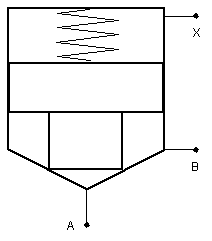Cartridge Valve Insert with Conical Seat
(To be removed) Hydraulic cartridge valve insert with conical seat
The Hydraulics (Isothermal) library will be removed in a future release. Use the Isothermal Liquid library instead.
For more information on updating your models, see Upgrading Hydraulic Models to Use Isothermal Liquid Blocks.
Library
Directional Valves
Description
The Cartridge Valve Insert with Conical Seat block represents an insert of a hydraulic cartridge valve consisting of a poppet interacting with the conical seat. The poppet position is determined by pressures at ports A, B, and X and force of the spring. A schematic diagram of the cartridge valve insert with conical seat is shown in the following illustration.

The Cartridge Valve Insert with Conical Seat block is a structural model consisting of a Hydraulic Cartridge Valve Actuator block and a Poppet Valve block, as shown in the next illustration.

Pressures at port A and port B tend to open the valve, while pressure at the control port X, together with the spring, acts to close it. The model does not account for flow rates caused by poppet displacement and any loading on the poppet, such as inertia and friction. The valve remains closed as long as the aggregate pressure force is lower than the spring preload force. The poppet is forced off its seat as the preload force is reached and moves up proportionally to pressure increase until it passes the full stroke. Hydraulic properties of the gap between the poppet and the seat are simulated with the Poppet Valve block.
Connections A, B, and X are hydraulic conserving ports associated with the valve inlet, valve outlet, and valve control terminal, respectively. The block positive direction is from port A to port B. Pressure at port X acts to close the valve, while pressures at port A and port B act to open the orifice.
Basic Assumptions and Limitations
Valve opening is linearly proportional to the pressure differential.
No loading on the poppet, such as inertia or friction, is considered.
The model does not account for flow consumption caused by poppet displacement.
Parameters
- Port A poppet area
Effective poppet area at port A. The parameter value must be greater than zero. The default value is
2e-4m^2.- Port A to port X area ratio
Ratio between poppet areas at port A and port X. The parameter value must be greater than zero. The default value is
0.66.- Preload force
Spring preload force. The default value is
26N.- Spring rate
Spring rate. The default value is
1.4e4N/m.- Poppet stroke
Maximum poppet stroke. The parameter value must be greater than zero. The default value is
0.005m.- Poppet diameter
Maximum poppet diameter. The parameter value must be greater than or equal to zero. The default value is
0.01m.- Seat cone angle
The cone angle of the valve seat. The default value is
120degrees.- Initial opening
The initial opening of the valve. Its value must be greater than or equal to zero. The default value is
0.- Flow discharge coefficient
Semi-empirical parameter for valve capacity characterization. Its value depends on the geometrical properties of the orifice, and usually is provided in textbooks or manufacturer data sheets. The default value is
0.7.- Laminar transition specification
Select how the block transitions between the laminar and turbulent regimes:
Pressure ratio— The transition from laminar to turbulent regime is smooth and depends on the value of the Laminar flow pressure ratio parameter. This method provides better simulation robustness.Reynolds number— The transition from laminar to turbulent regime is assumed to take place when the Reynolds number reaches the value specified by the Critical Reynolds number parameter.
- Laminar flow pressure ratio
Pressure ratio at which the flow transitions between laminar and turbulent regimes. The default value is
0.999. This parameter is visible only if the Laminar transition specification parameter is set toPressure ratio.- Critical Reynolds number
The maximum Reynolds number for laminar flow. The value of the parameter depends on the orifice geometrical profile. You can find recommendations on the parameter value in hydraulics textbooks. The default value is
12, which corresponds to a round orifice in thin material with sharp edges. This parameter is visible only if the Laminar transition specification parameter is set toReynolds number.- Leakage area
The total area of possible leaks in the completely closed valve. The main purpose of the parameter is to maintain numerical integrity of the circuit by preventing a portion of the system from getting isolated after the valve is completely closed. The parameter value must be greater than 0. The default value is
1e-12m^2.- Time constant
Sets the time constant of the first-order lag, which is introduced between the required and the actual poppet positions to account for actuator dynamics. The parameter value must be greater than zero. The default value is
0.01s.
Global Parameters
Parameters determined by the type of working fluid:
Fluid density
Fluid kinematic viscosity
Use the Hydraulic Fluid block or the Custom Hydraulic Fluid block to specify the fluid properties.
Ports
The block has the following ports:
AHydraulic conserving port associated with the valve inlet.
BHydraulic conserving port associated with the valve outlet.
XHydraulic conserving port associated with the valve control terminal.
